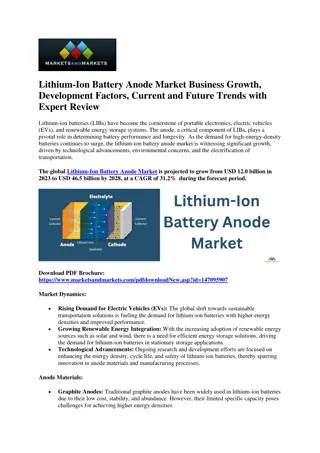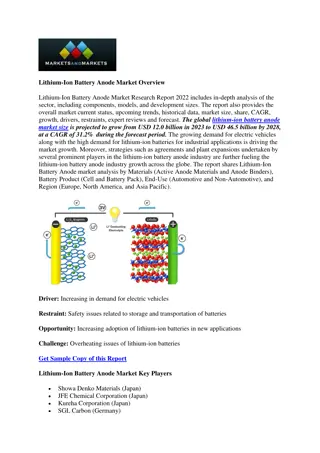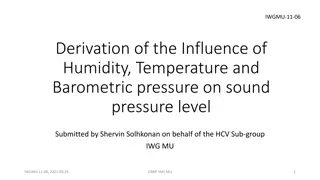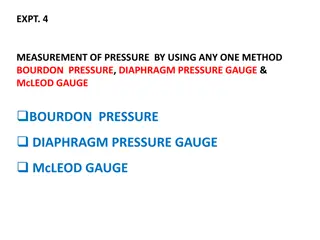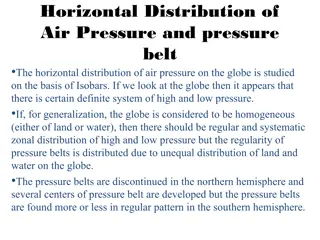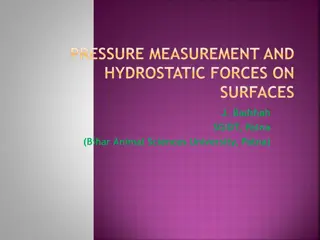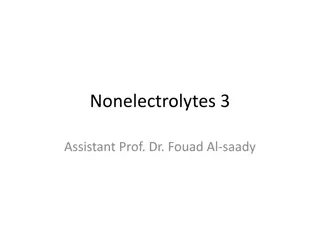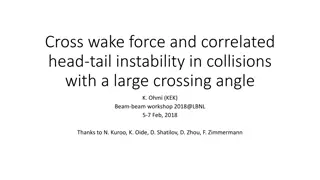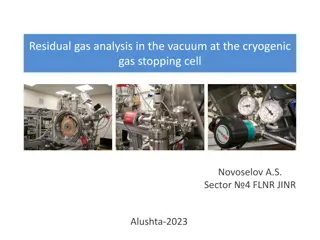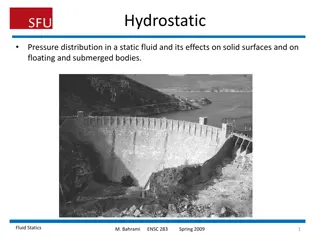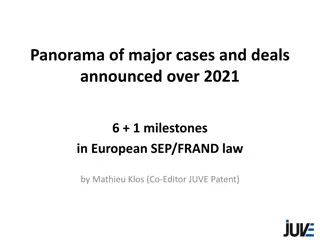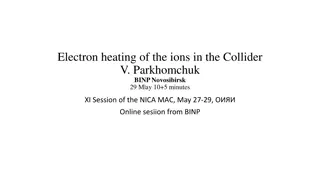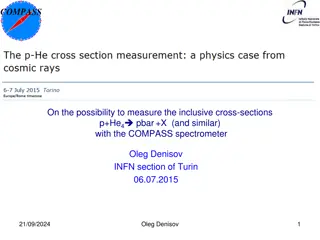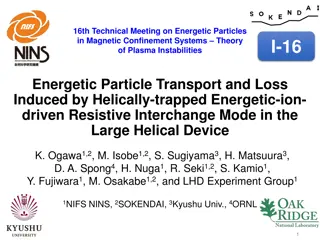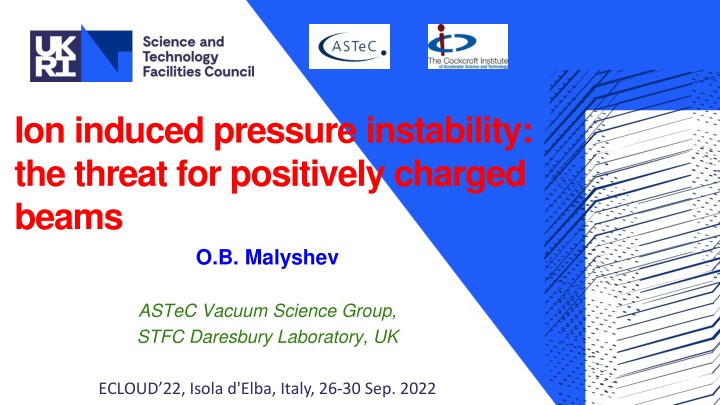
Ion-Induced Pressure Instability in Positively Charged Beams
Ion-induced pressure instability poses a threat to positively charged beams due to the formation of an ion cloud along their path. This instability leads to beam emittance blow-up and can be mitigated by improving pumping systems and utilizing ion collectors. The phenomenon involves the generation of electrons and ions from beam-induced gas ionization, resulting in electron clouds and gas desorption that impact beam stability.
Download Presentation

Please find below an Image/Link to download the presentation.
The content on the website is provided AS IS for your information and personal use only. It may not be sold, licensed, or shared on other websites without obtaining consent from the author. If you encounter any issues during the download, it is possible that the publisher has removed the file from their server.
You are allowed to download the files provided on this website for personal or commercial use, subject to the condition that they are used lawfully. All files are the property of their respective owners.
The content on the website is provided AS IS for your information and personal use only. It may not be sold, licensed, or shared on other websites without obtaining consent from the author.
E N D
Presentation Transcript
Ion induced pressure instability: the threat for positively charged beams O.B. Malyshev ASTeC Vacuum Science Group, STFC Daresbury Laboratory, UK ECLOUD 22, Isola d'Elba, Italy, 26-30 Sep. 2022
What is the ion induced pressure instability?
Ion induced instability with the negatively charged beams Residual gas molecules are ionised by the beam The positively charged ions build up an ion cloud along the negatively charged beam path CO2 beam + + + + + + + + H2 + + + + + The ions cause the ion induced beam instability + CO Mitigation: Better pumping system Ion collectors CH4 ECLOUD 22, Isola d'Elba, Italy, 26-30 Sep. 2022 O.B. Malyshev 3
Positively charged beams Electrons Ions 1.Electrons appear in vacuum chamber due to photoemission and electron from a beam induced gas ionisation 2.Electrons are accelerated by the beam charge and drift between bunches 3.These electrons may strike the vacuum chamber wall causing Secondary electrons Electron stimulated gas desorption (ESD) 4.These electrons build up an electron cloud that cause a beam emittance blow-up 5.Gas density increases causing a generation of more electrons from beam induced gas ionisation 1. Ions appear in vacuum chamber due to a beam induced gas ionisation 2.Ions are accelerated (repelled) from the beam by the beam charge and drift between bunches 3.These ions strike the vacuum chamber wall causing Ion stimulated gas desorption (ISD) Secondary electrons 4.Gas density increases causing a generation of more ions from beam induced gas ionisation 5.The electrons will contribute to an electron cloud built up e- e+ or A+ beam e- H2 e- CO H2+ e- CO2 CO H2 CH4 CO2 CH4 O.B. Malyshev ECLOUD 22, Isola d'Elba, Italy, 26-30 Sep. 2022 4
Pressure instability and critical current Critical current, Ic, is a current when pressure (or gas density) increases dramatically. Q Q S Mathematically: = = P P + _ _ e ring e ring I S eff eff e I 0 0 S S eff eff e Hence , I I c S e no I c eff = where I c I First observed at ISR storage ring at CERN in 1971 Studied for SSC (USA) LHC design (CERN) includes results of modelling ion induced pressure instability Then studied for ILC-DR In present is under investigation for FCC ECLOUD 22, Isola d'Elba, Italy, 26-30 Sep. 2022 O.B. Malyshev 5
Equation of gas balance The equation for the volumetric gas density inside a room temperature vacuum chamber n I A S n t q 2 n = + + + + q u t 2 z e ion stimulated desorption yield, I beam current, a cross section of the gas ionisation, qt electron charge; photon stimulated desorption yield, photon flux to the wall; electron stimulated desorption yield, electron flux to the wall; qt thermal desorption for room temperature systems u specific vacuum conductance. Similarly the equations could be written for a cryogenic beam chamber ECLOUD 22, Isola d'Elba, Italy, 26-30 Sep. 2022 O.B. Malyshev 7
Quasi-static conditions t n Then the gas density is described by where: c is the net effect between the wall distributed pumping speed and the ion induced desorption: c S = 0 V 2 d n dz cn q + = 0 u 2 I q e here, is a NEG coating sticking probability, S is an ideal pumping speed of sorbing vacuum chamber per 1 m of length, q is the PSD, ESD and thermal desorption term: q =hG+xQ+qt ECLOUD 22, Isola d'Elba, Italy, 26-30 Sep. 2022 O.B. Malyshev 8
Solution for quasi-static conditions The second order differential equation for the function n(z) has three solutions: Case (a) with 0 c n z c u c u q c z z = + + ( ) , C e C e 1 2 q u = = + + 2 Case (b) with 0 ( ) n z c z C z C 3 4 2 c u c u q c i z i z = + + Case (c) with 0 ( ) n z c C e C e 5 6 I q q =hG+xQ+qt = c S e ECLOUD 22, Isola d'Elba, Italy, 26-30 Sep. 2022 O.B. Malyshev 9
Solution for an infinitely long vacuum chamber In this case, there is no net axial diffusion, thus and the solution is: 2 d n = 0 2 dz + + q q c = = t n inf I q S e Critical current, Ic, is a current when pressure (or gas density) increases dramatically. Mathematically, there must be I S e 0 Hence, beam current should be Se I I , I I c = where c ECLOUD 22, Isola d'Elba, Italy, 26-30 Sep. 2022 O.B. Malyshev 10
Solutions for a short vacuum chamber In this case, the conditions at the extremities of the chamber have an influence on the gas density along the whole length of the chamber. Critical current calculated for various scenarios Critical current, Ic Conditions with a given pumping speed at the ends with a given gas density at the ends 0, C 0, 2 S L 2 eq q u + p + S e S 2 L = 0, C 0, 2 eq u L 2 S q p e 2 L ECLOUD 22, Isola d'Elba, Italy, 26-30 Sep. 2022 O.B. Malyshev 11
Multi-gas model In a beam chamber, several species coexist: H2, CO, CO2, etc. The ions can desorb different gas species. Therefore, the equilibrium equations for the gas density of each species will be cross-correlated to those of other species. A system of equations for N gas species, Ai (i=1,2 N): for volumetric gas density inside a vacuum chamber I 2 N n t n + j ( ) , A A + + + + + A n S C n q u i i i j = ; c j i i i i i i ti i 2 z q = 1 j e ECLOUD 22, Isola d'Elba, Italy, 26-30 Sep. 2022 O.B. Malyshev 12
Solution for an infinitely long vacuum chamber in two-gas model The gas density of the two components of the gas mixture is given by the system of two linear equations: + + 2 2 B q n c + + = ; 0 c n q d n 1 1 1 A B = ; 0 d n 2 A Solution: The stability conditions: The critical current: ( ) 2 ( ) + + 2 + + q d 2 1 c q d d c q d d 4 0 c c d d = ; n 2 1 = 1 2 1 2 1 2 cI 1 2 1 2 ( ) A A C ) inf A 1 2 c c q d c c 1 1 2 2 1 2 1 c 2 c 0 ( ( ) + + = . n 1 2 1 2 1 1 + + + + , , , , A A B B B B C = = = = ; ; A B inf B 0 1 2 + + + + ( , ) ( , ) I A A S q I B B S q c A A + A e c B B B e 1 2 1 2 ( ) ( ) + 1 1 + + + + , , , , A B A B C B A B A C = = = = ; . B A 1 2 + + + + ( , ) ( , ) I A B S q I B A S q c A A A e c B B B e ECLOUD 22, Isola d'Elba, Italy, 26-30 Sep. 2022 O.B. Malyshev 13
Multi-gas model For other boundary conditions in two-gas model the solutions become more complicated. All details can be found in Chapter 9 in O.B. Malyshev. Vacuum in particle accelerators : modelling, design and operation of beam vacuum systems. Wiley, 2020. For more than two gases numerical codes are preferable For example CERN s in-house code VASCO: A. Rossi. VASCO (VAcuum Stability COde): multi-gas code to calculate gas density profile in a UHV system. LHC-Project-Note-341, March 2004, CERN ECLOUD 22, Isola d'Elba, Italy, 26-30 Sep. 2022 O.B. Malyshev 14
Pressure instability thresholds What can be calculated for given beam parameters and vacuum chamber geometry: Ic critical current Required: I << Ic, where I is a maximum beam current Lc critical length between pumps Required: L << Lc, where L is an actual distance between pumps Sc critical pumping speed Required: S >> Sc, where S is an effective pumping speed at this location For room temperature and cryogenic vacuum chambers ECLOUD 22, Isola d'Elba, Italy, 26-30 Sep. 2022 O.B. Malyshev 15
Ion Stimulated Desorption yields ISD yields, defined as a number of gas molecules desorbed from the surface per incident ion, (molecules/ion): A 3 Q a m P s q C n = N molecules ion e q = , molecules N k T K I ions B where Q is a flux of molecules desorbed due to ion bombardment, I is the ion current, qe is the elementary charge and nq is the ion charge number ECLOUD 22, Isola d'Elba, Italy, 26-30 Sep. 2022 O.B. Malyshev 17
ISD yields as a function of ion energy A.G. Mathewson. Ion induced desorption coefficients for titanium alloy, pure aluminum and stainless steel. CERN-ISR-VA/76-5 (1976). O.B. Malyshev ECLOUD 22, Isola d'Elba, Italy, 26-30 Sep. 2022 18
ISD yields as a function of accumulated ion dose ISD yield as function of accumulated ion dose can be described as: * D D ( ) ( ) = * ; D D i i the exponent lies between 0.3 0.5 for as-received samples and between 0 1/3 for baked samples The ISD yields as a function of accumulated ion dose from (a) as-received and (b) baked aluminium and copper samples bombarded with argon ions at 5 keV. M.P. Lozano. Ion-induced desorption yield measurements from copper and aluminium. Vacuum 67 (2002) 339. O.B. Malyshev ECLOUD 22, Isola d'Elba, Italy, 26-30 Sep. 2022 19
ISD yields as a function of ion mass ISD yield from (a) unbaked and (b) baked stainless steel sample as a function of incident ion mass N. Hilleret. Influence de la nature des ions incidents sur les taux de desorption par bombardement ionique de mol cules adsorb es sur une surface d acier inoxydable. CERN-ISR-VA/78-10 (1978). O.B. Malyshev ECLOUD 22, Isola d'Elba, Italy, 26-30 Sep. 2022 20
Luck of ISD experimental data Most of data were obtained at CERN in 20th century Very little published, some data available in CERN Vacuum Notes and personal archives No new material and treatments were studied The Ion energy range needs to be extended ( ) = , , , ,... f E M material bakeout ion ion ( ) = , , , , ,... E f N T ion bunch x y ECLOUD 22, Isola d'Elba, Italy, 26-30 Sep. 2022 O.B. Malyshev 21
What is energy of ion hitting vacuum chamber walls? ( , , , ion bunch E f N T = ) , ,... x y
Ranges of varied beam parameters used for modelling Parameter Symbol and units Range beam current I (A) 0 1.5 1 1010 7 1011 particles per bunch Nb (ppb) r or x (m) r xy = x / y z (m) 10 8 10 3 rms bunch size beam aspect ratio 1 300 10 3 0.1 rms bunch length bunch spacing T (ns) 5 25 To cover ILC, LHC, FCC-hh and FCC-ee ECLOUD 22, Isola d'Elba, Italy, 26-30 Sep. 2022 O.B. Malyshev 23
Typical results: round beams The results are showing the main trends for varying bunch sizes, ion mass, beam current, bunch spacing and a vacuum chamber aperture Example: obtained for H2+ ions with a 3D Gaussian bunched beam with Nb = 1011 ppb z = 0.01 m, T = 25 ns and R = 20 mm ECLOUD 22, Isola d'Elba, Italy, 26-30 Sep. 2022 O.B. Malyshev 24
Typical results: round beams Nb = 7 1011 ppb Effect of two different bunch spacing: T = 5 ns and T = 25 ns. Nb = 1 1011 ppb ECLOUD 22, Isola d'Elba, Italy, 26-30 Sep. 2022 O.B. Malyshev 25
Typical results: round beams The H2+ average energy for 3D Gaussian bunched beams a function of beam current, I. ECLOUD 22, Isola d'Elba, Italy, 26-30 Sep. 2022 O.B. Malyshev 26
Typical results: round beams The ratios of average energies for H2+ ions to ones of CH4+, CO+ and CO2+ ions as a function of ion mass with bunch space T = 25 ns and the beam chamber radius R = 20 mm. O. B. Malyshev. The energy of ions bombarding the vacuum chamber walls. Round beams. Nucl. Instrum. Methods Phys. Res. A 933, 165068 (2021). ECLOUD 22, Isola d'Elba, Italy, 26-30 Sep. 2022 O.B. Malyshev 27
Typical results: elliptic beams The results for elliptic beams are compared to round beams Case (c) for and , where kshift is an empirical coefficient at which the results for and fit each other. = = r k x r shift y x xy ( ) r E E r ell xy ECLOUD 22, Isola d'Elba, Italy, 26-30 Sep. 2022 O.B. Malyshev 28
Effect of magnetic field dipole magnetic field: 1.4 - 20 T wigglers: up to 1.6 T solenoids: 2 - 4 T quadrupoles: 60 - 400 T/m = E E E E min max 0.5 E min r ( ) 2 mv q k B e ion q k R B 2 mv = , i x z N r = = E c max 2 2 m e i o n i ECLOUD 22, Isola d'Elba, Italy, 26-30 Sep. 2022 O.B. Malyshev 29
<E>(B) Average H2+ energy as a function of dipole field may vary by more than 2 orders of magnitude. Average CO+ energy as a function of dipole field reduces by a factor 2 More studies have to be done ECLOUD 22, Isola d'Elba, Italy, 26-30 Sep. 2022 O.B. Malyshev 30
Conclusions Ion induced pressure instability is a potential thread to positively charges machines Theory and models are written Used in design of SSC, LHC and in use FCC There is a luck of ISD data, no data for high energy What happened when ions with E = 104 107 eV hit vacuum chamber? Sputtering? Perforation? Cross-influence to ecloud to be studied in future There are no data on ion induced electron emission ECLOUD 22, Isola d'Elba, Italy, 26-30 Sep. 2022 O.B. Malyshev 31
References 1. O. Gr bner. The Dynamic behavior of pressure bumps in the ISR. CERN/ISR-VA/76-25. 8th June 1976. R.S. Calder. Ion induced gas desorption problems in the ISR. Vacuum 24, 437 (1974). E. Fisher and K. Zankel. The stability of the residual gas density in the ISR in presence of high intensity proton beam. CERN-ISR-VA/73-52. 9th November 1973. O. Gr bner and R.S. Calder. Beam induced desorption in the CERN Intersecting Storage Ring. CERN/ISR-VA/73-15. 27th February 1973. O. Gr bner. Dynamic pressure behavior in presence of beam induced gas desorption. ISR Performance Report. CERN, 19th December 1972. C. Benvenuti, R. Calder and N. Hilleret. A vacuum cold bore test section at the CERN ISR. IEEE Transaction on Nuclear Science, Vol. NS-24, No. 3, June 1977, pp. 1373 1375. C. Benvenuti and N. Hilleret. Cold bore experiments at CERN ISR. IEEE Transaction on Nuclear Science, Vol. NS-26, No. 3, June 1979, pp. 4086 4088. W. Turner. J. Vac. Sci. Technol. A 14, 2026-2038 (1996). - SSC O. Gr bner. Vacuum system for LHC. Vacuum 46, 797-801 (1995). 10. I.R. Collins, et al. Mechanical and vacuum stability design criteria for the LHC experimental vacuum chambers. EPAC-98, p. 2202-2204. 11. O.B. Malyshev and A. Rossi. Ion desorption stability in the LHC. Vacuum Technical Note 99-20, December 1999, CERN. - 76 pages 12. O.B. Malyshev and A. Rossi. Ion desorption vacuum stability in the LHC. EPAC-2000, pp. 948 950 (2000). 13. O.B. Malyshev. The ion impact energy on the LHC vacuum chamber walls. EPAC-2000, pp. 951 953 (2000). 14. I.R. Collins, et al. Vacuum stability for ion induced gas desorption. LHC Project Report 312, October 1999, CERN. -7 p 15. J. G mes-Go i et al., J. Vac. Sci. Technol. A 15, 3093 (1997). 16. J. G mes-Go i et al., J. Vac. Sci. Technol. A 12, 1714 (1994). 17. A.G. Mathewson et al. The ALICE Vacuum System. LHC Project Note 19, CERN, Geneva, 27 Nov. 1995. 18. A.G. Mathewson. Ion induced desorption coefficient for titanium alloy, pure aluminium and stainless steel. CERN-ISR-VA 76-05, CERN, Geneva, 1976. 19. A.G. Mathewson and S. Zhang. The beam-gas ionization cross section at 7.0 TeV. Vacuum Technical Note 96-01. CERN, January 1996. 20. I.R. Collins, et al. Mechanical and vacuum stability design criteria for the LHC experimental vacuum chamber. LHC Project Report 205, CERN, Geneva, 27 July 1998. 21. O. Malyshev. The energy of the ions bombarding the vacuum chamber walls. Vacuum Technical Note 99-17, CERN, Geneva, November 1999. 22. Handbook of Accelerator Physics and Engineering. Ed. A.W. Chao and M. Tigner. World Scientific Publishing Co. Pte. Ltd, 1999, p. 128. 23. M.P. Lozano. Vacuum 67, 339-345 (2002). 24. I. Collins, et al, Vacuum Calculations for the LHC Experimental Beam Chambers, LHC Project Report 492, CERN, Geneva, 6 Aug 2001. 25. A. Rossi, Residual Gas Density Estimation in the LHC Insertion Regions IR1 and IR5 and the Experimental Regions of ATLAS and CMS for Different Beam Operations, CERN LHC Project Report 783 (2004). 26. A. Rossi and N. Hilleret. Residual gas density estimations in the LHC experimental interaction regions. LHC Project Report 674, CERN, Geneva, 18 September 2003. 27. A. Rossi. VASCO (VAcuum Stability COde): multi-gas code to calculate gas density profile in a UHV system. LHC-Project-Note-341, March 2004, CERN. 28. O.B. Malyshev. Ion induced pressure instability in the ILC positron DR. IPAC 10, pp. 3566- 3568 (2010). 29. I. Bellafont, et al. Beam induced vacuum effects in the future circular hadron collider beam vacuum chamber. Phys. Rev. Accel. Beams 23, 043201 (2020). 30. O.B. Malyshev. Vacuum in particle accelerators : modelling, design and operation of beam vacuum systems. Wiley, 2020. 2. 3. 4. 5. 6. 7. 8. 9. ECLOUD 22, Isola d'Elba, Italy, 26-30 Sep. 2022 O.B. Malyshev 32



